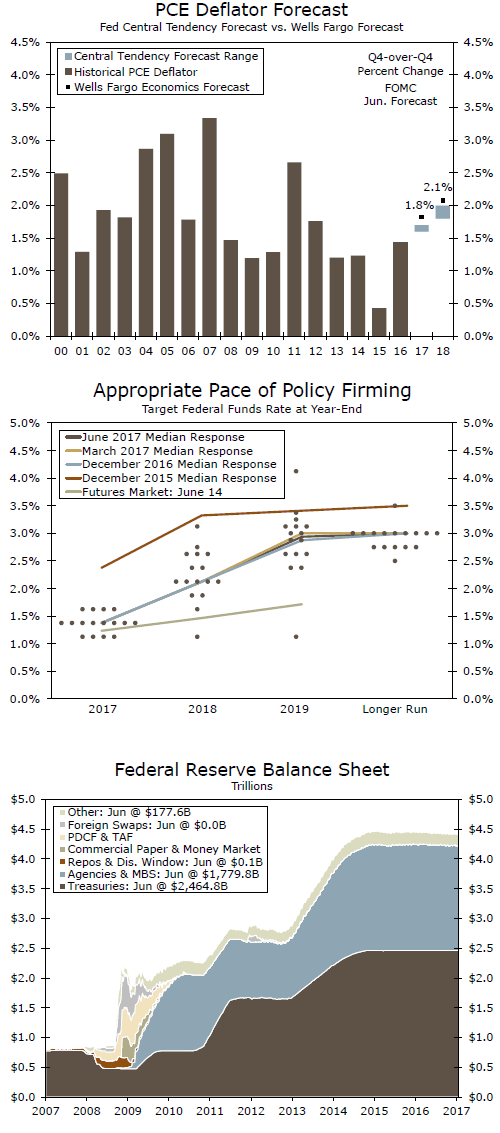Today, the FOMC raised the fed funds target rate and will make further adjustments depending on the path of incoming data. This policy path is consistent with past guidance, but we are skeptical about what lies ahead.
Future Expected Inflation Dominates Current Inflation
The FOMC raised its target for the federal funds rate by one-quarter percentage point and made some slight adjustments to its interest rate forecast going forward. The minimal changes to the Fed’s dot plot projections were also reflected in the economic forecasts. Real GDP growth was left essentially unchanged throughout the forecast horizon. The projection for the core PCE deflator was lowered for both 2017 and 2018 by 0.1 percentage point. Inflation, as measured by the PCE deflator, is expected to gradually rise but remain below the 2 percent target (top chart). The FOMC’s full employment target has been more or less met.
From the FOMC’s point of view, the model matters more than current inflation numbers. Based upon a low unemployment rate relative to expectations for full employment, future inflation should be rising as this model projects expected inflation toward the Fed’s two percent goal.
Have Model Then Generate Dot-Plot
Given the model’s projection of higher inflation, the FOMC projects one more rate hike in 2017, which also remains our forecast. However, this is highly dependent on a move upward in inflation. If inflation does not pick up, we expect no move in September. The dots showed 2018 and longerrun projections unchanged (middle chart).
The Fed’s longer-run median projection for the neutral fed funds rate is three percent; with a two percent inflation target, the real long-run fed funds rate is implicitly one percent. Such a low real funds rate indicates something about potential growth inconsistent with the goals of the current presidential administration.
The Fed’s Balance Sheet: Some Guidance, but Questions Remain
This afternoon’s release was accompanied by an addendum providing additional details regarding the Fed’s plans to normalize its balance sheet. The Fed stopped short of setting a specific time at which normalization would commence, only saying that they expected to begin implementing the program "this year." The Fed also refrained from setting a target end date/balance sheet size that would mark the end of normalization. The Fed did, however, confirm that it will implement normalization by decreasing its reinvestments of principal payments on maturing securities.
Specifically, the Fed will set a "cap" on the dollar amount of principal payments it will not reinvest, with all payments above this cap reinvested. The Fed anticipates that the cap will initially be $6 billion per month for Treasury securities and $4 billion per month for agency debt and mortgagebacked securities. The caps will then increase in steps of $6 billion and $4 billion, respectively, at three month intervals over a 12 month period until the caps reach $30 billion and $20 billion, respectively. On balance, this would be a relatively modest and gradual first step in reducing the Fed’s sizable $4.5 trillion balance sheet.















